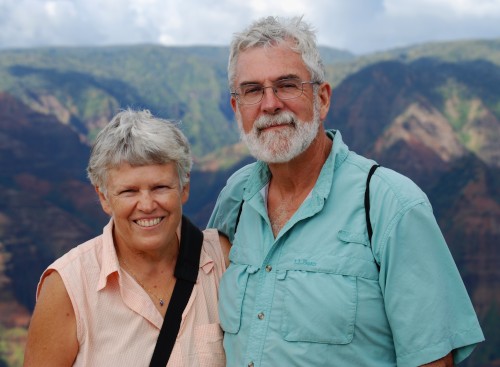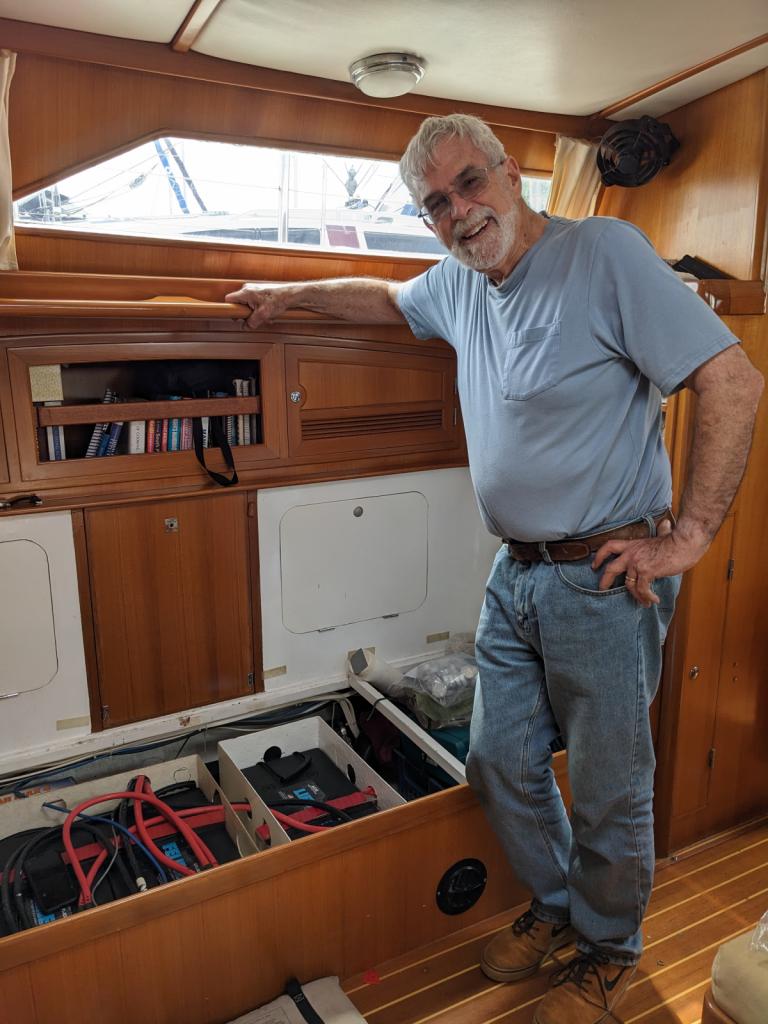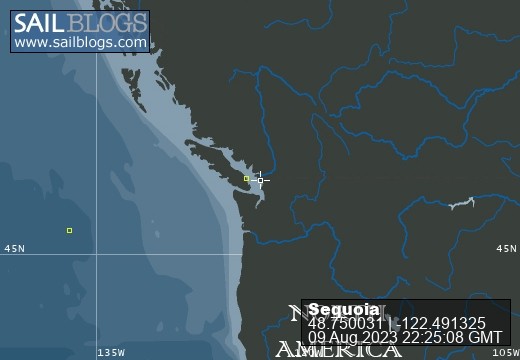
Sequoia Changing Latitudes
30 August 2023 | St. Helens, Oregon
09 August 2023 | Bellingham, Washington
21 July 2023 | Boat: Bellingham; C&B: Scappoose
10 July 2023 | Egmont, Sunshine Coast, B.C., Canada
02 July 2023 | Walsh Cove, Desolation Sound, B.C., Canada
23 June 2023 | Westview/Powell River B.C.
18 June 2023 | Ganges, Saltspring Island, B.C., Canada
22 June 2019 | Scappoose, Oregon
27 May 2019 | Back home in Oregon
09 May 2019 | Villas Alturas Hotel, Costa Rica
02 May 2019 | San Vito, Costa Rica
23 April 2019 | Golfito, Costa Rica
11 April 2019 | Panama City, Panama
04 April 2019 | Shelter Bay Marina, Colon, Panama
22 March 2019 | Jamaica
11 March 2019 | Zar Par Marina, Boca Chica, Dominican Republic
18 February 2019 | Culebra Island, Puerto Rico
31 January 2019 | Simpson Bay Lagoon, Sint Maarten
21 January 2019 | Nelson's Dockyard, English Harbour, Antigua
04 January 2019 | Portsmouth, Dominica
Oahu to Kaua'ia
01 July 2011 | Hawaii
Barbara/hot and humid in a pleasant tropical way
I’m sitting in “Da Fuel Dock” store, where they have a few washers and driers for the benefit of boats in the Ala Wai Yacht Harbor. Our laundry from the last week is merrily spinning around, biding its time until it next demands attention from me. Seems like a good time to do a trip update for you, my dear family and friends. Craig is off returning the rental car, Mark (new crew, who arrived yesterday) is tweaking a web page so that you, my lucky readers, can watch our day-to-day progress on our upcoming passage from Kaua’i to Oregon. (See www.navshare.com) Plus, Mark tells me, the daily position reports will be automatically available to Facebook subscribers.)
We’ve been provisioning the last few days, stuffing the refrigerator and freezer to the gills, and finding every vacant space in cabinets and under the cabin sole (floor) to stuff cans of this and that, bags of flour and blocks of hard cheese. I have two giant folding crates full of fruits, vegetables and eggs. Hopefully they’ll keep us in tasty fresh food for most of the voyage.
This afternoon we’ll fuel up (and retrieve the clean, dry laundry), and then head out the mouth of Ala Wai Yacht Harbor, destination: Hanalei Bay on the north side of Kaua’i. As we head out, I’ll throw my orchid lei overboard to float on the water, supposedly assuring my return to the island. There’s actually a side motive for throwing out the lei: I need the space in the refrigerator! Craig gave me that lei for our anniversary dinner -- two weeks ago – and it still looks as fresh as the day he gave it to me. Orchids are amazing that way!
We’ve had a great time in Honolulu. It starts and ends with the Hawaii Yacht Club, where we’ve had an oh-so-friendly welcome, an island of serenity within the tourist bustle of Waikiki. The club is busy now with preparations for the arrival of the Transpac fleet. The boats leave California on July 4, and the first boat is expected to arrive five days later. (That’s an astonishing time, considering we’ll take three weeks, more or less, to sail to Oregon.) Club members are attending committee meetings and work parties, all to get ready for the arrival of the racing yachts.
We rented a car for the two weeks we’ve been here. That allowed us to do some exploration outside of the Honolulu area, and we were able to do every conceivable Honolulu errand we wanted. Craig went to West Marine and Ace Hardware. I mostly went to grocery stores for the provisioning project, including Costco, Safeway, Walmart, Foodland and the Saturday Farmers Market at Kapiolani Community College. Perhaps the best provisioning (at least for fresh fruits and vegetables) was at the Chinatown vendors. The prices were the best in Honolulu, maybe because there are so many vendors, close to each other, and competing strenuously.
The prices in Honolulu – even Chinatown – are breathtaking. In a way that’s understandable, because most things come in on ships or airplanes. Local fruits/vegetables are priced equally high, if not higher, perhaps just because they can. But indeed the cost of living is much higher here, so the farmers have to make more money than on the mainland, just to live. The ultimate shopping experience (pricewise and otherwise) has to be the Whole Foods Market. I went there for the freshest possible produce (and that was successful) but the prices! Zucchini, $3.99 a pound. Tomatoes, $5.99 a pound. Radishes: $2.99 for a bunch – seven radishes! Yikes! I looked for a five-pound bag of plain old sugar at the Whole Foods Market, and they don’t even stock such a thing. Instead they have little bags of organic fancy-named sugars. Needless to say, I had to go to Safeway for some things, including that five pound bag of sugar.
One day we drove across the island, through the Ko’olau Range, through the rain showers and the fog, to the windward coast of Hawaii. At first, it’s just a big extended suburb (which could almost be Southern California), but as you travel northwest along the shore, the civilization thins out, and things become more scenic, more interesting. We stopped at He’eia State Park, which the Lonely Planet Guide describes as “looking abandoned.” I think the truth is that it rains so much there, everything is green, including some of the buildings. There were chickens wandering around, and below the banquet building (it advertises being a venue for weddings), we found a garden devoted to traditional Polynesian farming plants and techniques. Daniel, a friendly guy our age, apparently pure Hawaiian, was tending the garden. (Actually he was sitting on the steps “talking story” with a couple of other folks). Craig approached them (he is so much better at that than I), and asked about the garden. Daniel started telling us about the taro, including side trips to Hawaiian origin stories, explanations of language, and stories about his grandfather. We spent a couple of hours with him, learning many interesting things. “Aloha” means “breath of life given from above” (“ha” = breath of life; “alo” means God-given). Daniel said that ciguatera (a poison sometimes found in reef fish) is undoubtedly caused by mustard gas dumped in a Hawaii harbor. It affects the entire tropical world, he said. We are quietly skeptical.
Daniel became vehement when talking about were the actions of the US military in commandeering sacred land from the Hawaiians. He’eia State Park is an area that was formerly used for preparing a body after death. The body was then loaded onto a canoe. At dusk, the canoe was paddled across Kane’ohe Bay to Mokapu Penninsula, giving the mourners the illusion that the body was being transported to the great beyond. (Daniel pointed out that “kapu” – or in English, taboo – means that the land is sacred to Hawaiians.) But now the Marine Corps has the entire peninsula as its Hawaii base, including an airfield and a golf course. Daniel said that periodically, bones work their way up through the grass in the golf course, and the officials just shove them back in. Daniel has participated in talks with various government officials, who uniformly say they feel bad about the Hawaiian’s loss of access to their sacred ground and burial place. But the military is mighty and unwilling to give up its strategically located land, no matter how bad individual officers may feel about the whole thing.
We did many of the usual tourist things in Honolulu. We visited the Iolani Palace where the last royalty of Hawaii reigned before being ousted by local businessmen. We visited Chinatown, the Saturday Farmers Market, and of course Pearl Harbor. We visited the battleship Missouri and the Arizona Memorial, both very moving experiences. Our last outing was to the Bishop Museum, which contains a vast number of artifacts from Hawaii’s history. King Kameha’s fabulous cloak is there, made from the yellow feathers of 80,000 Mamo birds. The Mamo bird is now extinct and one wonders whether the King’s fabulous cloak had anything to do with it.
After the Bishop Museum closed, the festivities got underway for the arrival of the seven Polynesian canoes that sailed from New Zealand in April. The canoes were crewed by representatives of a number of different island nations, including the Marquesas, Tahiti, Tonga, Fiji, the Cook Islands, Samoa – all places we visited in our trip through the South Pacific. But these canoes had no GPS or modern navigating instruments, and relied instead on the Polynesian methods of navigation, passed down through the generations. On the central lawn of the museum, a covered bandstand had been set up, and we listened and watched a number of troupes of hula dancers, and we listened to speeches about the significance of this voyage. The canoes are heading for California next – and that would seem to be outside of the traditional Polynesian voyaging range. Although… Daniel of the taro patch assured us that ancient Hawaiians went to the west coast of North America. He thinks there are many similarities between native Hawaiian and native American cultures. He offers as an example the Hopi Indians. He’s just sure that they are a lost tribe of Hawaiians – you can tell from the name. Hawaiian: “Ho’opili” Just like Hopi, right?
We’ll spend a few days anchored in Hanalei Bay, swimming off the back step, exploring ashore a bit, and preparing the boat for the big passage. Provisioning – so we hear – is not an option on Kaua’i, at least not near Hanalei Bay. It’s a big resort place, and there are only a few convenience stores. I’m hoping there’s a Laundromat as well.
[Later] I was unable to finish up this trip report before we left Honolulu. We traveled overnight and had a nice sail, a few rain showers, and a spectacular star show. Arriving here in Hanalei Bay we were struck by the exotic tropical character of the place. Mark’s comment was that it looks like the set for “Lost.” We haven’t been ashore yet, just relaxing after the overnight passage. I’ll try to write again before we leave on passage for Oregon (tentatively slated for July 6). If you like, you can follow our progress across the ocean here: www.navshare.com. Follow the link to see a map of our most recent position report (you may have to use the zoom out to get an understandable picture.
Comments
| Vessel Name: | Sequoia |
| Vessel Make/Model: | Outbound 44 |
| Hailing Port: | Portland, Or |
| Crew: | Craig & Barbara Johnston |
| About: | |
| Extra: |
Sequoia's Photos - Main
Who we are...

Who: Craig & Barbara Johnston
Port: Portland, Or



